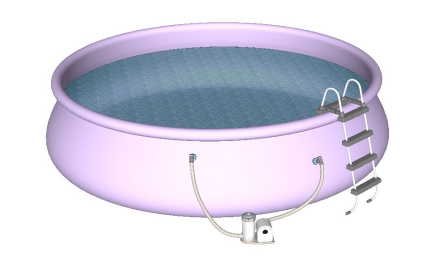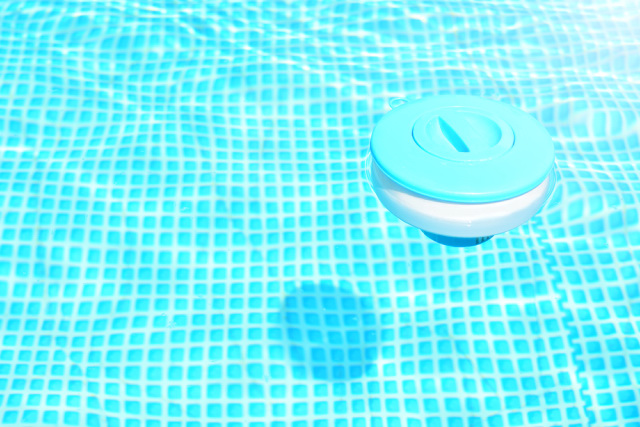Over the years, I have come to view Intex pools as an attractive and more cost-efficient method for above-ground and permanent pools. But like any pool, they need proper care and chlorine is usually the chemical of choice for Intex pool owners.
There are, however, many different types of pool chlorines available. Which one is the best or most suitable choice for an Intex pool?
Liquid chlorine, household bleach, and dichlor are the preferred choice of chlorine for an Intex swimming pool. These chlorines will minimize any potential damage to the pool liner, such as bleaching or weakening. Calcium hypochlorite can also be used as a shock for an Intex pool, but it should be thoroughly dissolved before adding to the water.
Choosing the wrong chlorine for your Intex pool could have expensive consequences. Let’s take a closer look into what chlorine you should use when and why they make the best choice for Intex pools.

Article Contents
Why Chlorine Choice Matters for Intex Pools
There are several different types of Intex pools and the construction of these pools varies. Models include:
- Kiddie Pools
- Easy Set
- Metal Frame Pools
- Prism Frame Pools
- Ultra XTR Frame Pools
In general, Intex pools use vinyl, resin or plastic to form the inside of the pool. These materials need special care. Kind of like the way you wash wool sweaters differently from cotton T-shirts.
The right chlorine will boost longevity and preserve the condition of your lining material. It will also ensure your pool has clear water and remains algae-free.
You Intex pool will need more than chlorine to keep it clean. If your pool doesn’t have a filter, check out our article which explains how you keep a pool like this clean: How To Clean a Small Pool Without a Filter
The Impact of the Wrong Chlorine on an Intex Pool
Choosing the best chlorine for your Intex pool will often make a difference in whether an Intex pool lasts for half a decade or whether you need to get a new one each summer.
Pools with liners, Intex pools, need a certain amount of care and should not be subjected to having strong chlorine, such as dichlor or trichlor touching them.
Using strong chlorines that dissolve slowly in Intex pools can:
- Cause wrinkles in the liner
- Bleach the liner
- Weaken the liner
- Shorten the liner’s lifespan
Which Chlorine Should You Use for an Intex Pool?
Here’s the short answer to what chlorine to use in an Intex pool.
The best choice of chlorine for an Intex pool is to use sodium hypochlorite (liquid chlorine or bleach) if you have the correct stabilizer levels. If the stabilizer is low, use dichlor or a combination of dichlor and liquid chlorine.
When choosing a chlorine type for your Intex pool, picking a chlorine type that, dissolves quickly, and isn’t too strong, is a good choice.
Using dichlor will add stabilizer to the water, which means your stabilizer levels will increase.
Warning: Do NOT mix different chlorines together though. By that I mean, don’t mix them in the same bucket or add them into the pool at the same time. It’s not safe. You may however add them in at separate times, and use a different measuring bucket for each.
And the long answer…
There are 5 common types of chlorine pool owners use to sanitize their pools. They are:
- Dichlor
- Trichlor
- Calcium hypochlorite
- Sodium hypochlorite (liquid chlorine or household bleach)
- Lithium hypochlorite
Let’s look at each of these chlorines in-depth to see if they are good choices for Intex pools.
Is Dichlor Suitable for Intex Pools?
Dichlor is an excellent choice of chlorine for an Intex pool. It isn’t as strong as trichlor or cal-hypo and dissolves quickly.
It’s because of this that it is less likely to bleach or wrinkle or damage an Intex pool liner in any way.
When using dichlor, it’s important to dissolve it in pool water first before adding it to your pool. This will minimize the undiluted chlorine coming in direct contact with the liner.
Do keep in mind, dichlor is a stabilized chlorine and should only be used in your Intex pool if your stabilizer levels are below 50 ppm. For saltwater pools, only use dichlor if stabilizer levels are below 60 ppm.
Is Trichlor Suitable for Intex Pools?
When it comes to your Intex pool, it’s best to avoid using Trichlor. Trichlor has been shown to cause damage to pool liners. A test study found that when Trichlor was used, pool liners showed signs of bleaching and were more likely to weaken.
Although saying that, it is likely the biggest problem is having a strong concentration of trichor on the pool liner or pool sides. This happens when chlorine floaters get stuck at one end of the pool or if you don’t use a floater.

If you are thinking about trichlor, don’t let the tablets sit on the bottom of the pool. It’s best to use a floater. And with a floater, be careful it doesn’t get stuck in one part of the pool.
Is Calcium Hypochlorite (Cal-hypo) Suitable for Intex Pools?
Calcium hypochlorite is one of the strongest chlorine available on the market. And because of this, it shouldn’t be used to regularly chlorinate your Intex pool.
Instead, use cal-hypo as a pool shock in your Intex pool. Always make sure you properly dissolve it first though. You don’t want the power or granules to touch the bottom of your pool as they will damage it.
Is Sodium Hypochlorite (Liquid Chlorine or Bleach) Suitable for Intex Pools?
Liquid chlorine or bleach aka sodium hypochlorite is a great choice of chlorine for Intex pools. Liquid chlorine is not a strong chlorine and mixes extremely quickly in your pool. It’s these two things that help to protect your Intex pool liner.
Liquid chlorine designed from swimming pools is about twice as strong as household bleach. Household bleach is usually around 6% strength, whereas liquid chlorine for pools is around 12%. Aside from this, they are the same thing.
If you use household bleach in your Intex pool, you’ll need to use twice the amount, by volume, as you would for liquid chlorine sold for swimming pools. The other important factor is to check that the bleach you use doesn’t contain added chemicals like perfumes or colors. It needs to be pure sodium hypochlorite.
Click Here to Check Price >>
Is Lithium Hypochlorite Suitable for Intex Pools?
Lithium hypochlorite isn’t a good choice for Intex pools. It’s not as readily available as other chlorines such as dichlor or liquid chlorine. And it’s more expensive than other chlorine kinds.
It’s for these reasons that I recommend you do not use lithium hypochlorite for an Intex pool.
Is Stabilized or Unstabilized Chlorine Better for Intex Pools?
Chlorine types are divided into two categories; stabilized and unstabilized. Which one should you use in your Intex pool?
A combination of both stabilized and unstabilized chlorines for an outdoor Intex pool is best. If your pool is indoors, unstabilized chlorine is best.
This may sound a little confusing. How do you know which chlorine to use when? And how much of each do you need?
Let’s take a look at each type of chlorine.
Stabilized Chlorine
Stabilized chlorines have a chemical additive, cyanuric acid (CYA), which prevents protects the chlorine from the sun’s UV rays. Without cyanuric acid (aka stabilizer) in the water, the chlorine would dissipate and become useless in a matter of hours.
Chlorines in this group include:
- Dichlor
- Trichlor
Unstabilized Chlorine
Unstabilized chlorine does not have cyanuric acid, or stabilizer added. It’s suitable for indoor pools and for increasing the chlorine level in outdoor Intex pools when you don’t want to increase the stabilizer levels.
Too much stabilizer is a bad thing as it decreases the chlorine’s effectiveness. It should be maintained at a level of 30-50 ppm.
When Should You Use Stabilized Chlorine?
Stabilized chlorine should be used in your Intex pool when stabilizer levels (CYA) are below 30 ppm. 30 ppm is the minimum amount of stabilizer you should have in a chlorine pool. This amount of stabilizer is less in saltwater pools.
If you test your water and find the levels are below 30 ppm, switch to using dichlor, which is a stabilized chlorine.
If the stabilizer levels are zero or under 25 ppm, it’s better to add in stabilizer separately. This way you can quickly increase stabilizer levels.
When Should You Use Unstabilized Chlorine?
Unstabilized chlorine should be used when you have the correct stabilizer levels. That is 30-50 ppm. Unlike some pool chemicals, stabilizer stays in the water and doesn’t evaporate or naturally reduce.
The only way to remove the stabilizer is by taking water out of the pool. For example, draining, backwashing or if your pool overflows with rainwater will remove the stabilizer from the water.
That’s why it’s important to not keep adding stabilizers to your Intex pool. It’s common to only need to add a stabilizer to your pool a couple of times per year. The rest of the time you should be using unstabilized chlorine.
How Much Chlorine Do You Need in an Intex Pool?
For all chlorine pools, including Intex pools, the chlorine levels should be maintained at 1-5 ppm. Around 3 ppm is ideal.
You can raise these levels by adding:
- Pool shock (cal-hypo)
- Dichlor (powder/granules)
- Liquid chlorine or household bleach (like Clorox)
The table below shows how much chlorine per 10,000 gallons (37,854 L) of pool water is needed to raise the chlorine level by 1 ppm.
| Chlorine Type | Amount |
| Dichlor | 2.3 oz (65.2 g) |
| Liquid Pool Chlorine (12% strength) | 11 oz (311.8 g) |
| Household Bleach (6% strength) | 21 oz (595.3 g) |
| Cal-Hypo (73% strength) | 1.8 oz (51 g) |
Can Chlorine Tablets Damage Pool Bottom or Liner?
Remember we mentioned earlier about liner damage and bleaching? Often, the little things you do in terms of pool maintenance end up damaging your pool and the cleaning equipment. A simple mistake can cause you a ton of money in repair expenses and replacing your pool equipment.
So, can chlorine tablets damage the pool bottom or liner?
If chlorine tablets come in contact with your pool liner in your Intex pool, they will damage it. Chlorine is a strong chemical, which means it will weaken the pool liner and likely bleach it too if it touches the liner or pool bottom.
That doesn’t mean you shouldn’t use chlorine tablets though. You can use them if you’re careful and use them properly. The safest way to use chlorine tablets in an Intex pool is to use a chlorine floater or chlorine feeder (aka chlorinator).
If you do use a chlorine floater, make sure it doesn’t get stuck in a corner or near the steps. This will cause an area of the pool that has a high concentration of chlorine and it can damage the liner.
Using a chlorinator is the safest way as it slowly dissolves chlorine tablets in a controlled way.
Can Chlorine Granules Damage Pool Bottom or Liner?
Chlorine granules will damage the liner or bottom of your pool if they touch it. Dichlor and calcium hypochlorite are the two most common chlorines that come in granules or power.
Like chlorine tablets, both these chlorines will cause weakening or bleaching of your Intex pool liner if they touch it.
The best way to use these chlorines is to dissolve them first in a bucket of pool water. That way, the full-strength granules will not touch or cause harm to your pool liner.
Once dissolved, I pour this solution into your Intex pool.
Related Reading: 5 Chlorine Options to Keep Kiddie Pools Clean and Safe







